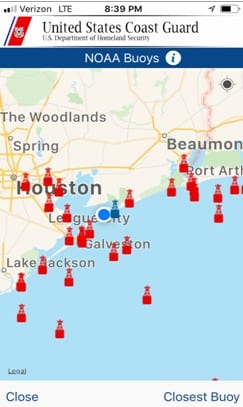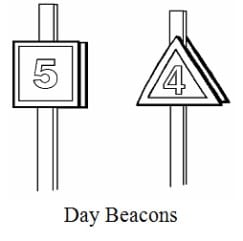 By Bob Currie, Vessel Examiner
By Bob Currie, Vessel Examiner
United States Coast Guard Auxiliary Flotilla 081-06-08
Flotilla 081-06-08 is based at Coast Guard Station Galveston. The Coast Guard Auxiliary is the uniformed civilian component of the US Coast Guard and supports the Coast Guard in nearly all mission areas. The Auxiliary was created by Congress in 1939. For more information, please visit www.cgaux.org.
Last week I shared the Coast Guard Recreational Boating Accident Statistics for 2016 with you. The leading cause of casualties was a collision with another recreational boat, followed by collision with a fixed object. This week we will look at some measures you can take to minimize your risk of becoming one of the above statistics.
Review Charts
Although charts are not required in most recreational boats, the prudent boater reviews charts before venturing out onto the water. Be sure that you have the most updated charts, especially after a hurricane has been through the area. I have both official paper charts and the latest charts loaded onto my GPS. Whenever I navigate to certain areas of the bay, I follow safe trails that I save in my GPS.
Keep a Proper Lookout
The Navigation Rules, International – Inland states that “Every vessel shall at all times maintain a proper lookout by sight and hearing as well as by all available means appropriate in the prevailing circumstances and conditions, so as to make a full appraisal of the situation and of the risk of collision.” A sharp lookout is often the first means of protection for the boat to avoid trouble. Some examples of collision risks are:
- Ships and boats (avoid running in the ship channel in recreational boats)
- Land (unintentional grounding has caused many accidents)
- Obstructions (the bays are covered with capped off wells with just stand pipes above the surface)
- Lights (navigation lights line the intracoastal waterway and ship channel)
- Buoys (navigational and NOAA buoys can be found all around)
- Beacons (buoys and beacons indicate the sides of a navigable channel)
- Discolored water (can indicate a submerged object or shallow reef)
- Reefs (our bays are covered with shallow oyster reefs)
- Whales, dolphins and sea turtles (Marine mammals and sea turtles can be tricky to detect. Look for these clues: blows, spouts, dorsal fins, heads, splashes, turtle shells, and flukes.)


It is important to choose a boat speed that will allow the lookouts to perform their duties.
Use Binoculars
Binoculars are the lookout’s best tool to increase their distance vision capabilities. They are very good for identifying contacts far off and obtaining detailed information when they get closer. While they do increase the distance the eye can see, they also reduce a person’s field of vision or how much the eye can see. It is important to remember to switch between using binoculars and just eyes to make sure nothing goes unnoticed.
Wear Sunglasses
On a sunny day, a large portion of the horizon might be difficult to observe due to the sun’s reflection on the surface of the water. A good pair of sunglasses will reduce eyestrain and glare allowing vision where normally it would be difficult. Polarized fishing glasses even further reduce the glare from the sun reflecting on the water.
Use Scanning Techniques
The lookout’s method of eye search is called scanning. Scanning is a step-by-step method of visually searching for objects. Good scanning techniques will ensure that objects are not missed. Scanning also reduces eye fatigue. Development of a systematic scanning technique is important. There are two common scanning methods:
- Left to right and back again
- Top to bottom and bottom to top
In either case, move eyes in increments. This creates overlaps in field of vision and fewer objects will be missed. When looking for an object, scan the sky, sea, and horizon slowly and regularly. Scan from left-to-right and back again or from top-to-bottom and bottom-to-top. When scanning, do not look directly at the horizon; look above it. Move head from side to side and keep eyes fixed. This will give any stationary objects in the field of vision the appearance of moving and make them easier to see. One technique is to scan in small steps of about 10° and have them slightly overlap while moving across the field of view. Fatigue, boredom, and environmental conditions affect scanning. For example, after prolonged scanning, with little or no contrast, the eyes develop a tendency to focus short of where the person is looking. To prevent this, periodically focus on a close object such as whitecaps or the bow of the boat.
Fog Scanning
In the fog, a contact might be heard long before it’s seen. Early detection is vital. Since the fog reduces visual distance, binoculars are not recommended. It is better to have a wide field of vision than a narrow magnified one. It is also important to position the lookout where they will not be hindered by background noise and other distractions. Usually the bow is best, if conditions allow. In severe fog, a second designated lookout should be stationed to cover the aft portion of the vessel.
Important Recall Notice
The US Coast Guard has recently recalled over 2500 Honda and Tohatsu outboard engines. The recall involves the fuel system; the vapor separator float ingests fuel allowing the float to sink in the assembly. The USCG says that this allows the relief valve to open, which may result in fuel overflow from the air ventilation hole to the outside of the engine. 2522 units are affected. The recall number is for American Honda Motor Co. and includes models BF 115 through 250, for years 2016 and 2017. In addition, Recall number 170017T is for an additional 130 Tohatsu engines including models BFT 115 through 250, for years 2016 and 2017. Contact your dealer who will make repairs at no charge. For more information click on this link:
http://cdn.powerequipment.honda.com/marine/pdf/recalls/P-PTB54841-RC84-Poster.pdf
For more information on boating safety, please visit the Official Website of the U.S. Coast Guard’s Boating Safety Division at www.uscgboating.org. Questions about the US Coast Guard Auxiliary or our free Vessel Safety Check program may be directed to me at [email protected]. I am available to perform free Vessel Safety Checks, and I will come to your location to perform them. SAFE BOATING!
[2-26-2018]

 Posted in
Posted in 























